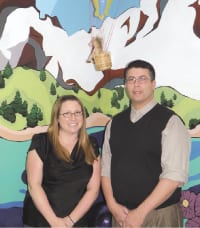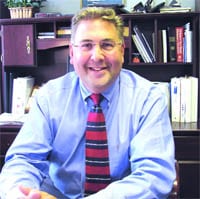The Whole Tooth Pediatric Dentists Stress Education, Prevention, and Fun
Drs. Howard Kantor and Marie Tremblay have a brochure in their Northampton office titled, “If Only I’d Known,” and the pediatric dentists say educating parents about what they can do to prevent tooth decay is a critical component of their profession.
“It’s not necessary for tooth decay to be part of a child’s experience. Kids can go through their entire lives without having a cavity if their parents are proactive in terms of diet, brushing, and flossing,” said Kantor, adding that they have seen tooth decay in toddlers as young as 18 months.
Dr. Robert Matthews at The Kid’s Dentist in West Springfield agrees. “Baby teeth are building blocks for the future of a healthy mouth,” he said. “In the long run, it’s cheaper to treat children’s teeth early before they get extensive tooth decay.”
The American Dental Assoc. and the American Academy of Pediatric Dentistry recommend that children see a dentist on or before their first birthday. And, although many people might dispute the necessity of consulting with a professional when teeth are just starting to emerge, experts say a pediatric dentist is as important to a child’s health as a pediatrician.
“The idea is to establish a dental home. It’s not to fix teeth,” Tremblay said, adding that parents should start gently brushing their children’s teeth with a child-sized toothbrush as soon as they erupt, using water or children’s toothpaste to get rid of plaque.
During an initial visit to Pediatric Dental Associates of Greater Springfield in East Longmeadow, pediatric dentists Drs. Vincent Trimboli Jr. and Laurie Brown discuss nutrition, its effect on teeth, what to do if a child falls and injures a tooth, and even the importance of having children wearing a helmet with a cage when they play sports such as soccer or teeball. They also explain the benefits and risks of fluoride and how baby teeth differ from adult teeth.
“The anatomy of a baby tooth is different. It has more nerve tissue and thinner enamel than an adult tooth,” Brown said. “So we are trained to treat these teeth differently.”
She added that dental decay is the number-one chronic disease in children. “But it is something that we can control with proper diet and hygiene habits.”
Clearly, dentists who work regularly with children educate their patients as much as they clean and repair teeth. But steering kids to a lifetime of good oral habits — and making the process fun for their often-anxious patients — is a rewarding challenge.
Knowledge Is Power
If teeth aren’t cared for, they can affect a child’s overall health. Baby teeth are present in the mouth during the years of growth and development. So if a child has a toothache, he or she may not get the proper nutrition to grow properly. Baby teeth also affect a child’s speech and hold a space for the adult teeth.
Pediatric dentists advise parents who fear dentists to let them do the talking and use their knowledge to make children comfortable. They are well-equipped to do this, they say, because they are required to complete two to three additional years of training in seven areas of specialty.
In addition to classes in child growth, development, and behavior management, Trimboli noted, they are trained in sedation techniques and must care for medically compromised children and adults before graduation. The population ranges from individuals with seizure disorder to those with autism-spectrum disorders and cerebral palsy, so dentists must learn how to handle children with special needs. They’re also trained to deal with childhood fears, explain things in a way a child understands, and accomplish necessary dental procedures quickly.
“We are trained to know how our patients will behave and how to approach them as soon as see we them walking down the hall and talk to them and their parents,” Trimboli said, explaining that they pay attention to a child’s body language and how well they interact with people in the waiting room or their staff. “We engage them before we ever use any dental instruments because we want them to have a positive experience.”
Brown gives each child a toy to play with as soon as they are seated in pint-sized examination chairs.
In fact, pediatric dental offices are carefully designed to be inviting to the small set. Matthews’ office has child-sized chairs, and the equipment he uses is smaller than the adult version, which makes it easier for children to tolerate procedures. Computer screens are installed on the ceilings of his treatment rooms and continuously play Disney movies, while Disney posters add a cheerful ambience, and stuffed animals sit on counters for children to hold during treatment. Plus, they can choose a small toy to take home when they leave.
Tremblay and Kantor’s office is also filled with fun. “It’s almost like trick-or-treating when children come here,” Tremblay said. “We give them sunglasses to wear so the light doesn’t shine in their eyes, along with stickers, gifts from our treasure drawer, and a toothbrush and toothpaste. And they get a coupon for a free slice of pizza.”
Brown and Trimboli’s office is like a small village, with rooms for every age, from tots to teens. Each room has a theme, such as Disney or a jungle, and lightscapes on the ceilings feature glowing pictures of fish swimming in turquoise water. Trimboli loves the Beatles, so one of the teen spaces is filled with Beatles posters and a glass case holding a collection of guitars. The dental equipment is hidden beneath counters and pulled out right before use, so children don’t get frightened when they enter the exam rooms.
“What we do affects how the children act, so we try to make the office and our treatment as non-intimidating as possible,” Brown said, adding that she gives small children a stuffed animal to hold to take the focus off the dental procedure.
These extras — along with child-friendly terms pediatric dentists use, such as calling the suction device “Mr. Thirsty” — go a long way toward making a visit to the dentist enjoyable.
More Than Smiles
However, there is a lot more to pediatric dentistry than atmosphere and small treats. Dentists provide parents with valuable education and tell them what is normal, what to expect, and also to check to make sure a child’s bite is developing properly.
Kantor said babies who want a bottle at bedtime should be given water, as once they are asleep, saliva production is reduced, and the sugar in milk or juice remains on their teeth. This also happens when mothers breastfeed throughout the night. “The milk has natural sugars which bathe the teeth,” he said, adding that it can lead to decay.
Sippy cups can also lead to tooth decay if children carry them around all day. “Some children use sippy cups as a pacifier. The child’s teeth should be wiped off after they drink from one,” Matthews advised.
Parents should also brush and rebrush their children’s teeth, as the young ones’ limited dexterity makes it unlikely that they will do a good job. Kantor tells parents to stand or sit behind a child and have the child look up so they can see their entire mouth.
Dentists agree that it’s much easier for everyone if tooth decay is discovered early. “A cavity is a progressive disease and will continue to get worse if it is not taken care of. Cavities should be fixed while they are small,” Tremblay said.
Brown said that, if cavities are caught early enough, they can sometimes be healed or remineralized with a combination of fluoride, proper hygiene, and newer toothpaste and dental products.
He and Trimboli say it’s not uncommon to see 2-year-olds with 10 cavities. But the way a baby tooth is restored is different than procedures used on adults.
In cases where a cavity is deep or a child is very young, it may be necessary to use sedation or put him or her in the hospital to fill it so they can be put to sleep. And if the decay has progressed to the point where the tooth has to be pulled, space maintainers are necessary. If they are not installed, the baby teeth will shift, and the adult teeth may not come in properly.
If decay has reached the nerve and the child will have the tooth for a number of years, pediatric dentists may opt to do a pulpotomy, which is the equivalent of a partial root canal on a baby tooth. “We take out part of the nerve tissue and put in a little stainless-steel crown to protect the rest of the tooth,” Tremblay said. “We don’t want it to abscess, as there is a permanent tooth building beneath it.”
Early orthodontic intervention can also prevent problems. Matthews recently hired an orthodontist to address issues that can be seen as early as age 6. “We want to catch problems early, while the jaw is still developing,” he said.
Trimboli said X-rays and oral exams reveal problems such as extra teeth, missing teeth, double teeth, and cysts. The earlier they are identified, the easier it is to plan a course of action.
In short, there’s a lot more to pediatric dentistry than a small smile. “It’s the whole experience,” Trimboli said. “Most children don’t go to an internist, they go to a pediatrician, which is why they can benefit from a pediatric dentist.”



